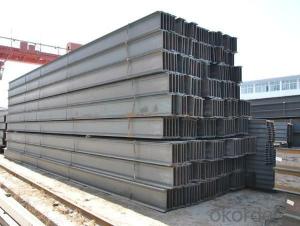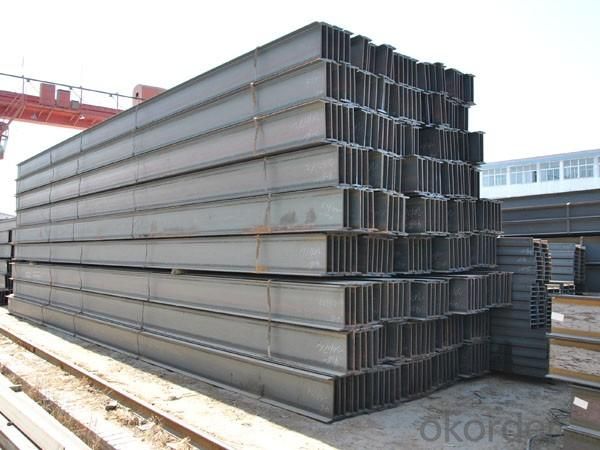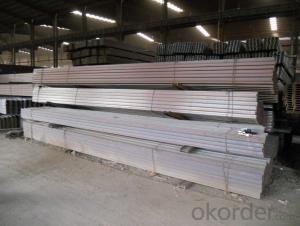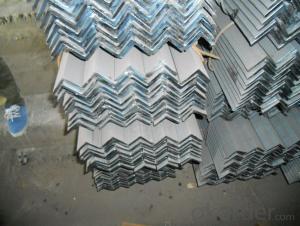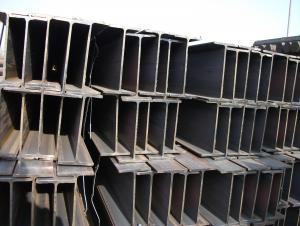Hot Rolled Steel I-Beam Q345
- Loading Port:
- Tianjin
- Payment Terms:
- TT OR LC
- Min Order Qty:
- -
- Supply Capability:
- 200000 m.t./month
OKorder Service Pledge
OKorder Financial Service
You Might Also Like
Specifications of Hot Rolled Steel I-Beam Q345
Standard: ASTM A36, EN10025, JIS, GB, etc.
Grade:S275, S355, SS400, Q235B, A36, Q345, etc
Sizes: 80MM-270MM
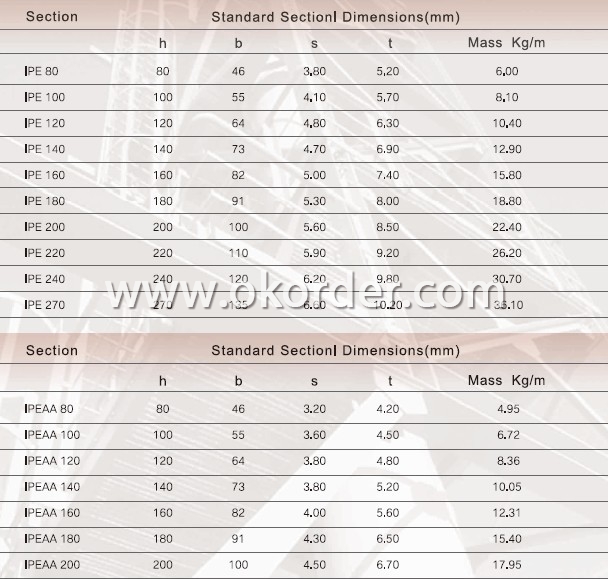
Applications of Hot Rolled Steel I Beam
Hot Rolled Steel I Beam is widely used in various building structures and engineering structures such as roof beams, bridges, transmission towers, hoisting machinery and transport machinery, ships, industrial furnaces, reaction tower, container frame and warehouse etc.
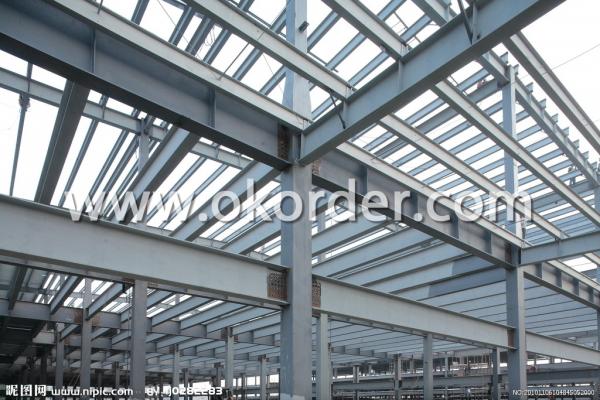
Package & Delivery Terms of Hot Rolled Steel I Beam
1. Package: All the hot rolled steel I beam will be tired by wire rod in bundles
2. Bundle weight: not more than 3.5MT for bulk vessel; less than 3 MT for container load
3. Marks:
Color marking: There will be color marking on both end of the bundle for the cargo delivered by bulk vessel. That makes it easily to distinguish at the destination port.
Tag mark: there will be tag mark tied up on the bundles. The information usually including supplier logo and name, product name, made in China, shipping marks and other information request by the customer.
If loading by container the marking is not needed, but we will prepare it as customer request.
4. Transportation: the goods are delivered by truck from mill to loading port, the maximum quantity can be loaded is around 40MTs by each truck. If the order quantity cannot reach the full truck loaded, the transportation cost per ton will be little higher than full load.
5. Shipment: In containers or in bulk cargo

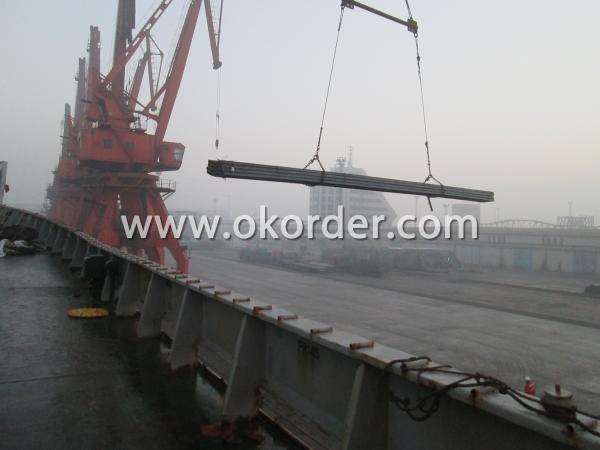
6. Delivery time: All the hot rolled steel I Beam will be at the port of the shipment within 45 days after receiving the L/C at sight ot the advance pyment by T/T
7. Payment: L/C at sight; 30% advance payment before production, 70% before shipment by T/T, etc.
Production flow of Hot Rolled Steel I Beam
Material prepare (billet) —heat up—rough rolling—precision rolling—cooling—packing—storage and transportation
- Q: Can steel angles be painted over?
- Indeed, painting over steel angles is possible. To ensure a successful outcome, it is vital to first guarantee that the surface is thoroughly cleansed and devoid of any dirt, oil, or rust. Accomplishing this can be done by utilizing a wire brush or sandpaper to eliminate any loose particles, followed by wiping the surface with a clean cloth. Once the surface is adequately prepared, it is necessary to apply a specialized primer created for metal surfaces in order to enhance adhesion and prevent corrosion. After the primer has dried, a suitable paint can be administered using a brush, roller, or spray gun. It is advisable to select paints specifically formulated for metal applications to ensure proper adhesion and durability. Over time, routine maintenance and repainting may be necessary to uphold the appearance and safeguard the steel angles from corrosion.
- Q: Can steel angles be used in outdoor or exposed environments?
- Yes, steel angles can be used in outdoor or exposed environments. Steel angles are commonly used in construction and engineering projects and are known for their durability and strength. They are often galvanized or coated with protective finishes to prevent rust and corrosion, making them suitable for outdoor use. Additionally, steel angles can withstand various weather conditions, making them a reliable choice for outdoor or exposed environments.
- Q: What are the common finishes available for steel angles?
- There are several common finishes available for steel angles, depending on the desired aesthetic appeal and level of protection required. Some of the most common finishes include: 1. Mill finish: This is the most basic and untreated finish, which is achieved by leaving the steel angle in its natural state after the manufacturing process. It has a rough, gray appearance and provides minimal corrosion resistance. 2. Hot-dip galvanized: This finish involves immersing the steel angle in a bath of molten zinc, which creates a protective coating on the surface. Hot-dip galvanizing provides excellent corrosion resistance and is commonly used in outdoor applications where the angle will be exposed to harsh environments. 3. Powder coating: This finish involves applying a dry powder to the steel angle, which is then heated and cured to create a durable and decorative coating. Powder coating provides a wide range of colors and textures and offers good corrosion resistance. 4. Painted finish: Steel angles can also be painted using various types of paint, including epoxy, enamel, or acrylic-based coatings. Painting provides a decorative finish and can also offer some degree of corrosion resistance, depending on the type and quality of the paint used. 5. Stainless steel: Steel angles made from stainless steel offer a distinct finish that is resistant to corrosion, staining, and rust. Stainless steel angles are often used in applications where hygiene, aesthetics, and longevity are important, such as in the food processing and medical industries. It's important to consider the specific requirements of your project, including the environment and intended use of the steel angle, when choosing the appropriate finish. Consulting with a steel supplier or expert can help you determine the best finish for your needs.
- Q: Are steel angles suitable for manufacturing support brackets for pipes?
- Yes, steel angles are suitable for manufacturing support brackets for pipes. Steel angles are known for their strength and durability, making them an ideal material for supporting heavy loads such as pipes. They provide excellent structural support and can withstand the weight and pressure exerted by pipes. Additionally, steel angles are resistant to corrosion, which is crucial when dealing with pipes that may come into contact with moisture or chemicals. Their versatility allows for various design options, making it easier to customize support brackets to fit specific pipe sizes and configurations. Overall, steel angles are a reliable and practical choice for manufacturing support brackets for pipes.
- Q: Can steel angles be used in the construction of oil refineries?
- Yes, steel angles can be used in the construction of oil refineries. Steel angles are commonly used in construction projects due to their high strength and durability. They provide structural support and are suitable for various applications, including the construction of oil refineries. The angles can be used to create frameworks, supports, and bracing for different components and equipment within the refinery. They offer stability and resistance to heavy loads and harsh environments, which is essential in the oil refining industry. Additionally, steel angles can be easily welded, bolted, or connected to other steel members, making them a versatile choice for refinery construction.
- Q: What are steel angles?
- Steel angles are L-shaped structural components made from steel, typically used in construction and engineering projects. These angles have two perpendicular legs that provide strength and stability, making them suitable for various applications such as supporting beams, framing structures, and reinforcing corners. Steel angles come in different sizes and thicknesses to meet specific project requirements and can be easily welded, bolted, or screwed into place.
- Q: What is the typical corrosion resistance of steel angles?
- The typical corrosion resistance of steel angles can vary depending on the specific grade of steel used and the environmental conditions in which they are exposed. However, in general, steel angles have a moderate to high level of corrosion resistance due to the presence of alloying elements such as chromium, nickel, and molybdenum. These elements form a protective oxide layer on the surface of the steel, which helps to prevent further corrosion. Additionally, the use of coatings or treatments such as galvanization or painting can further enhance the corrosion resistance of steel angles. Ultimately, it is important to consider the specific application and environment in order to select the appropriate grade of steel angle with the desired level of corrosion resistance.
- Q: What are the maximum allowable lengths for steel angles?
- In various applications and industries, the maximum lengths allowed for steel angles can vary depending on specific factors and regulations. These regulations are set by industry standards and guidelines. The maximum lengths are generally determined by considering the strength of the material, the intended load it will bear, and the structural design. Steel angles are commonly used in construction and engineering for framing, bracing, and support. The maximum lengths are often specified by building codes, engineering standards, or project-specific design criteria. These regulations ensure that the angles can withstand the anticipated loads and provide sufficient structural stability. To determine the maximum lengths for steel angles in a particular application, it is important to refer to the appropriate industry standards and regulations. It is also advisable to consult with a qualified structural engineer or designer. These professionals consider factors such as the dimensions, thickness, and material properties of the angle, as well as the specific load requirements. This ensures that the chosen length is safe and effective for meeting the project's needs.
- Q: What are the different types of steel angles used in modular furniture?
- There are several different types of steel angles used in modular furniture, including equal angles, unequal angles, L-shaped angles, and slotted angles. These angles are used to provide structural support, reinforcement, and stability to the furniture pieces.
- Q: What are the common shapes and dimensions of steel angles?
- The common shapes of steel angles include equal angles, unequal angles, and L-shaped angles. The dimensions of these angles can vary widely, but some common sizes include 1/2 inch, 3/4 inch, 1 inch, 1-1/2 inch, and 2 inches. The thickness or gauge of the angles can also differ, typically ranging from 1/8 inch to 1/4 inch.
Send your message to us
Hot Rolled Steel I-Beam Q345
- Loading Port:
- Tianjin
- Payment Terms:
- TT OR LC
- Min Order Qty:
- -
- Supply Capability:
- 200000 m.t./month
OKorder Service Pledge
OKorder Financial Service
Similar products
Hot products
Hot Searches
Related keywords
